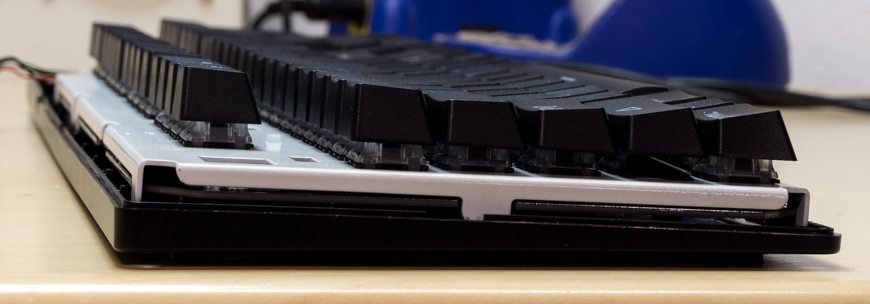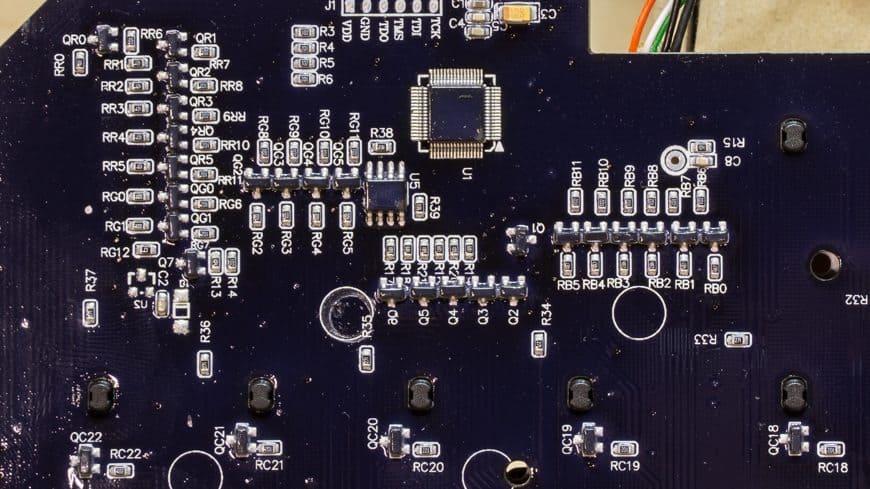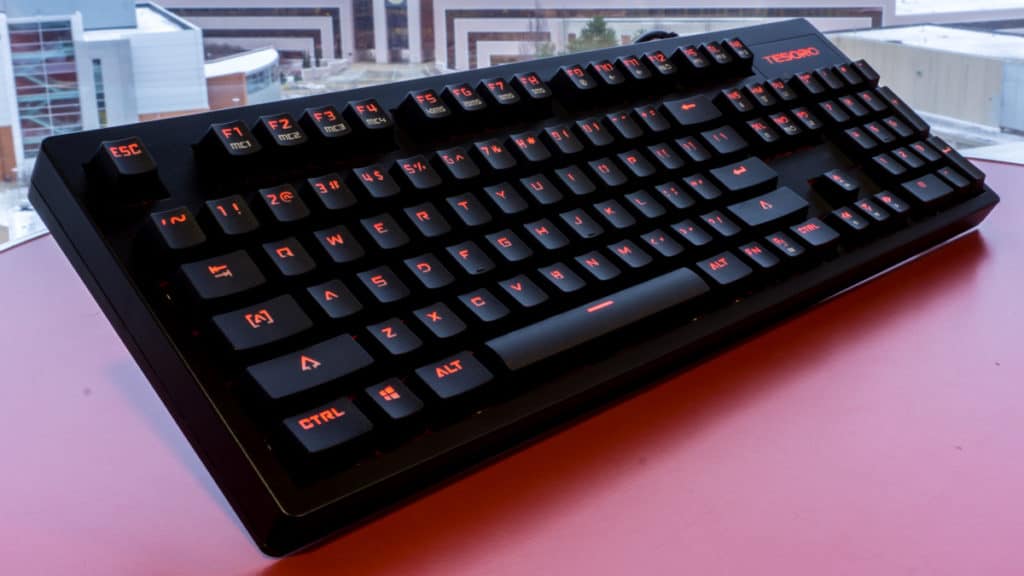Optical mechanical keyboard switches are essentially new to the North American market. Tesoro, a company best known in Europe, chose to step in with their brand-new optical switch technology in a bid to capture American buyers.
I’m familiar with Tesoro and am very excited to review their newest mechanical keyboard – the Excalibur SE Spectrum. Tesoro produces gaming peripherals and is well known for its line of sleek mechanical keyboards.

I’ve been using the Tesoro Excalibur Spectrum for quite some time in order to get a better feel for the mechanical keyboard. Check out my unboxing and review of the Tesoro Excalibur below. In this review, I will take apart the Tesoro Excalibur Spectrum and show you the pros and cons of the mechanical keyboard.
Unboxing the Tesoro Excalibur SE Spectrum
The Excalibur SE Spectrum arrived in a box with one remarkable feature: its printing. The glossy graphics on its front and back give an impression of quality. In addition, rich shades of pastel purple pull your eyes to various features.




The box’s contents, however, are sparse. The SE Spectrum is adequately protected for shipment in a plastic sleeve, but it comes with zero accessories. The absence of a keycap puller is somewhat disappointing, as every first-time mechanical keyboard owner wants to pull a keycap. They’ll be stuck doing so with a butter knife unless they own another mechanical keyboard. With that out of the way, let’s discuss the mechanical keyboard itself.
Build quality
The outer case of the Tesoro Excalibur is composed of nicely textured ABS plastic, though there are mild variations in texture between the lower and upper case halves. A small gap around the edge of the translucent logo/lock light plate allows a bit of light to escape. On the rear of the upper case, raised plastic ridges outline what appear to be audio and USB ports that were removed from the mold. It’s curious that they’re still present; I don’t think I’ve ever seen someone try to recycle an injection mold before. A few marks are also present around the bottom case’s lip.

The mechanical keyboard feels reasonably solid on flat surfaces, but it suffers if you pick it up or use it on your lap. Uneven pressure causes loud creaking noises. Pressing down on the center of the bezel results in significant flex and mild creaking. None of those noises present themselves during regular use, but you can bet that the Tesoro Excalibur would be creaking away if stuffed haphazardly into a backpack full of gaming gear. When I disassembled the keyboard, I snapped a tab on the rear of the case. That actually reduced the creakiness of the keyboard after reassembly.


Things are quite different inside the case of the Tesoro. Popping the mechanical keyboard open reveals a weak design. Note the piece of factory-applied electrical tape in the top-center, which may be for creak reduction. The Spectrum SE’s case halves have no support latticework inside, resulting in flexibility.
Hollow cylindrical pegs support the PCB and plate, but no screws attach the PCB to the lower or upper case. Plastic screws with thin threads hold the case edges in place. I’m not convinced that they’ll stay secure over time, but the use of 7 screws might keep things tight.

The PCB and plate, which are the only real source of structure on the Tesoro Excalibur, are held in place by pressure and a single loose through-PCB support. Other pressure fit implementations have multiple holes for tight through-PCB supports, making the case and PCB/plate for flex reduction.
Even that technique might not help with Tesoro’s design, though. Individually, the plate and PCB are very nice. The plate is thick, utilizing 90-degree folds near its edge for additional stiffness. The SE’s PCB is beefy, nicely soldered, and covered with a conformal coating.

Yet, in a fascinating move, the two components are held together by plastic pegs. Most keyboards rely on soldered switch legs to hold the plate in place. Hot swappable optical switches make that impossible. In my opinion, the plastic pegs are inadequate. Standoffs and screws would have been a better choice for overall quality and stiffness. They’re also much more expensive, which was almost certainly a consideration in the design process.
If the PCB flexes, warps, or gets displaced for any reason the optical sensors move relative to the switch stems. You can see mild sagging near the left of the PCB in the photo above. In theory, that will change the activation point of all switches in the upper left-hand corner of the mechanical keyboard by a small amount, the worst case being the Esc key. It may not be noticeable in practice, but it’s an oversight nonetheless.

The Tesoro Sprectrum cable isn’t removable or braided, but it is well made. Its thickness, beefy strain relief, glued internal connector, and reasonably sized USB plug should last for quite some time.
The Spectrum’s tiny flip out feet is great for stationary use, as a rubber coating makes them extra grippy. Things might not look so good if you’re a traveling gamer. If you shoved the Tesoro Spectrum into a tightly packed bag with its feet out, for example, I’m not sure that they would survive. The same goes for dropping or leaning on it.
The case’s rubber pads are thick, textured, and quite pleasant. They stick out a long way, which means that sliding the keyboard into a bag carelessly isn’t a good idea. The pads might peel away on the edges of books or laptop cooling stands.
Tesoro Excalibur – Switches & stabilizers

Tesoro markets their optical switch’s reduced response time as game changing for the gaming industry. In reality, an extra millisecond probably won’t help your K:D ratio. The best gamers in the world might benefit from the extra time, but those of us who live near the center of the bell curve won’t be able to perceive a difference.
That said, the clicky blue optical switches are smooth, responsive, and innovative. They don’t seem to suffer from binding or scratchiness, even when subjected to unrealistic sideways pressure. Their amazing bind resistance is probably due to their IR beam stem, which extends far into the lower switch mechanism. The optical components are rated for 10 million hours, so Tesoro Excalibur keyboards should last for ages.

The blue optical switches from the Tesoro aren’t perfect, though. Tesoro blues make moderately loud rattling noises. They also have fairly loose stems, which I’ll touch on later. The rattle presents itself after the downstroke click and during the upstroke. Faster key presses reduce the rattling slightly, but it’s still audible.
If you enjoy gaming with tactile clicky switches, Tesoro’s IR blues would be a solid choice. Tesoro blues activate below their click/tactile point. While that’s useful for typists, it’s not ideal for gaming. Pressing keys rapidly can be tiring due to the switches’ relatively heavy weight and tactile point. If you hold the keys below their tactile point and above their actuation point it makes rapid presses faster, but more fatiguing and difficult.
Ultimately, I think that typists who game will enjoy Tesoro blues more than gamers who type. Overall, the Tesoro’s Excalibur Spectrum has great switches and I’ve enjoyed gaming and typing with them quite a bit.
Stabilizers
The Excalibur SE Spectrum uses Costar stabilizers. They make swapping keycaps more difficult while preserving the natural feel and sound of stabilized keys. Cherry stabilizers have plastic tabs that reduce bottom out the noise and add a cushion. When I removed a key to view the stabilizers, I found well-applied lube. That’s great!

Lube, however, doesn’t solve scratchiness that I experienced when pressing several stabilized keys. I think it’s due to loose switch stems. Pressing a stabilized key results in a rotation, which in turn causes the stabilizer wire to track improperly. The result is mild to moderate binding and grinding. Still usable, but not pleasant. The space bar doesn’t suffer from binding problems, though. In fact, it’s probably my favorite key to press on the whole keyboard!
Tesoro Excalibur – Keycap quality

The SE Spectrum showcases standard gamer-font thin doubleshot ABS keycaps. They’ll get quite shiny as your fingers wear away the plastic, but the main legends won’t wear off. A few of the sub legends are pad printed. They’re not on heavily used keys, so they should last for a while.
Excalibur Spetrum Features

The SE Spectrum’s controller returns to a default backlight setting when its power is cycled. Resetting the backlight mode after PC reboots is bothersome. I know that flash memory is present, as user profiles persist after power loss. Why not use that memory for storing backlight states?
That said, the RGB LEDs in the Tesoro SE Spectrum are good. They’re reasonably bright and exceptionally even. The switches have neat lenses that spread light across the bottom of the keycap, which accounts for the solid coverage. A bunch of modes, 7 color options, and two user configurable backlighting profiles are available. The Tesoro logo is backlit and configurable, but it can’t be shut off in user profiles. Only the lock LEDs are non-RGB. That isn’t a big deal, but it is a minor eyesore if blue clashes with your color preferences.
Configuration can be tedious. An individual key must be pressed multiple times to select the desired color. Fn + PgUp puts the keyboard into LED programming mode. The same keys are used to save and exit. The combo saves and exits while advancing the PgUp backlight by one color. If you have the PgUp key set to red, for example, exiting programming mode will switch it to green. To land on the right color you must memorize the color sequence or spam the Fn + PgUp key 14+ times. The Fn key backlight is completely disabled in user modes, leaving the keyboard one key short of its advertised capabilities.
“Every one of the keys has its own backlighting and can be assigned as pleased.” — Tesoro Product Page
My contact at Tesoro is working to document those behaviors, which is great. I hope to see a firmware fix too.
Power usage
Certain backlighting choices turn the SE Spectrum into a power hog. It draws 65 mA at idle, which isn’t a huge deal. If you turn its LEDs on and set them to purplish-white, the keyboard pulls 500 mA from my laptop’s USB 3 port. That’s the flat out maximum current allowed for one device on a USB 2 port, which is what most keyboards are designed around. I would prefer to see 450 mA current draw. That would leave a margin of error for poor USB 2 implementations.
Water resistance

Tesoro put a lot of effort into making the SE Spectrum water resistant. The PCB sports a conformal coating (which contains some factory dust), the switches use stainless steel springs, drains funnel water away from vital components, and the optical mechanisms are unlikely to short.
While I wouldn’t advise dunking your mechanical keyboard, you don’t need to be paranoid about water spills. The water resistance is a refreshing feature of Tesoro’s Excalibur Spectrum and I’m glad to see they put in the effort to have it. After gaming or using your PC for 5+ hours a day, something is bound to happen.
Macros & Fn keys
The rest of the Spectrum’s Excalibur features are generic. Macro keys, which share space with F1-F4, are configurable through another in-keyboard process. A minimal function layer provides volume controls, Win and Fn locks, and a few bits.
Labels & branding

The backlit Tesoro logo is stenciled on a sheet of translucent plastic. Its coating is fairly durable. Be careful to avoid scratches anyways, as light will shine through them.
“Break the Rules” is pad printed above the arrow cluster in a durable glossy substance. My representative at Tesoro clarified what the slogan means. It isn’t encouraging gamers to break the rules. Instead, it represents Tesoro’s brand. They defy the norm to bring customers innovative products.

The bottom label is plasticized and utilizes high contrast printing. Good stuff.
Tesoro’s Excalibur Spectrum – Editor’s opinion
I thought I would dislike the backlit Tesoro logo. In a shocking twist, I think it’s pretty cool. The gamer-font keycaps still seem unappealing, though.
The Excalibur SE Spectrum is a good looking keyboard that has a few flaws. Nonetheless, it is a usable and enjoyable mechanical keyboard for gaming or just general use. If you’re a typist first and a gamer second, this keyboard could do the job for you.
If you’re a gamer first and a typist second, I advise holding out for Tesoro red optical switches. I’m amazed by how well Tesoro’s blue optical switches perform in terms of smoothness and off center presses, so I have high hopes for future releases. I’m very pleased to have had the opportunity to review and play around with the Tesoro Excalibur Spectrum.
This mechanical keyboard has a nice design and interesting features such as its water resistance. If you’re still interested in this gaming RGB mechanical keyboard, I highly recommend you check it out on Amazon, there are plenty of reviews. For a review of the Tesoro Gram Spectrum, check out my article here.
We rate mechanical keyboards on a 10 point scale. 10 is absolute perfection, 6 is average, and anything less is increasingly bad. The Tesoro Excalibur SE Spectrum scored a 6.2, making it slightly better than average.

